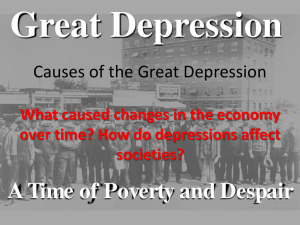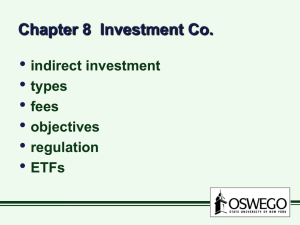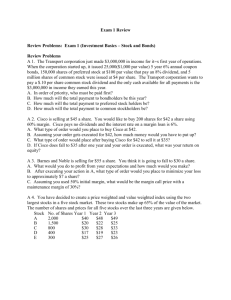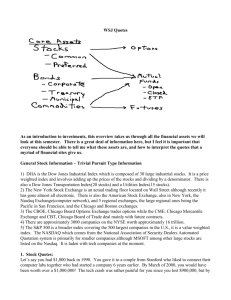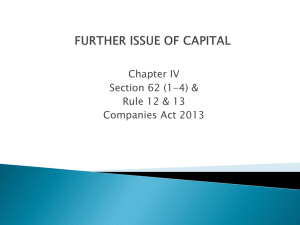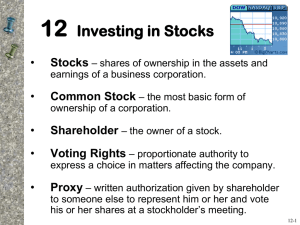Getting Rich Quickly in the 1920*s
advertisement
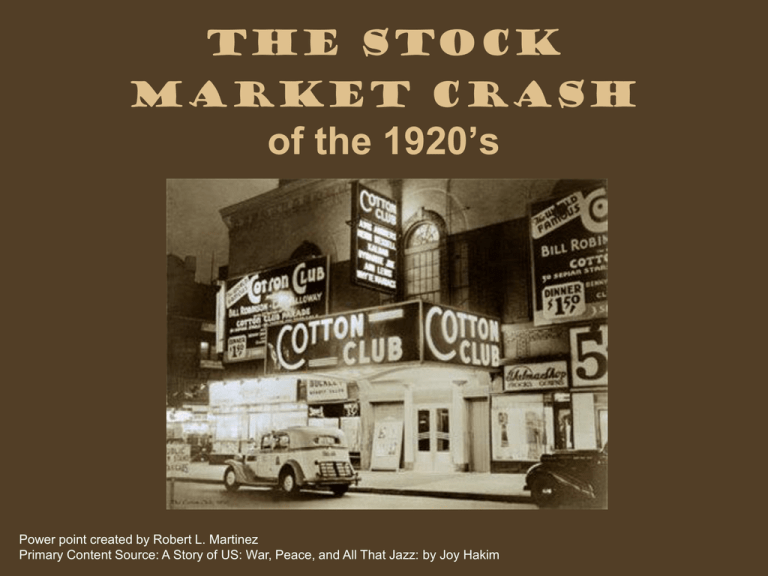
The Stock Market Crash of the 1920’s Power point created by Robert L. Martinez Primary Content Source: A Story of US: War, Peace, and All That Jazz: by Joy Hakim • In 1927, ‘28, and ‘29 it was easy to get rich. All you had to do was put a little money in the stock market. Here is how it worked. • Imagine that you are the owner of a large company: the Tech Automobile Company. You make good cars, and now you want to expand. You need to build a new plant and buy a lot of equipment. • So you decide to look for investors. You go public. This means you sell shares in your company to raise money. • So, you sell shares in your company. You sell 10,000 shares at $100 each. The shares are called “stock.” Anyone who buys stock becomes a part owner of the Tech Auto Company. • Your new cars are a big success. The company earns a great deal of money. The stockholders get a percentage of the profits. That money is called a dividend. • The future of your company looks good. Many people want to buy stock in the Tech Automobile Company. • Here is where the rule of economics, called the law of supply and demand, comes in. There are only 10,000 shares available. There is a big demand for Tech Automobile stock. Prices go up! • People will pay $110 a share for it. Later, they will pay $120 a share. Before long, Tech Automobile stock is selling for $200 a share. • One stockholder, Mr. Martinez, bought 10 shares at $100 each (total is $1000). Now, he will sell them at $200 each. What is his profit? ($1,000). He has doubled his investment. • Easy to make money that way, isn’t it? Well, hold on. In the 1920s, it was even easier than that. People bought stocks on margin. • Margin means they borrowed most of the money. Today, laws restrict margin buying. Margin means you don’t have to pay the whole $100 for $100 worth of stock. • In 1927, you could pay $10 (down payment), and borrow the other $90 from the stockbroker. A stockbroker is a person who buys and sells stock for you. • Now, if Mr. Martinez puts $100 into Tech Automobile stock and buys on margin at 10 percent, he can have 10 shares instead of one (worth $1,000). • If he sells the shares for $200 each. He has to pay back the money he borrowed, $90 per share ($900 total), but he still makes a whole lot of money. $1,000 profit, with only $100 originally out of his pocket. • The business of buying and selling stocks is called the “stock market.” the place where stocks are bought and sold is called a “stock exchange.” • The most important stock exchange is in New York City, on Wall Street. Brokers from all over the world call Wall Street with orders to buy and sell stock. • The stock market usually reflects the business world. If things are going well, stocks go up. If business is poor, stocks go down. • Brokers have a nickname for an “up” market. They call it a “bull” market. A down market is a “bear” market. • The Twenties were a prosperous time. Around 1924, the stock market started rising. In 1927, the market began to rise like a comet. Almost overnight, stocks doubled and sometimes tripled in value. • Everyone was excited. Newspapers wrote about it. Many politicians and business leaders were saying that the economic boom would just go on and on. No end in sight. Respected economic professors agreed. • Now, suppose you are living in 1927. All your friends are getting rich and you aren’t. You feel like a dummy. Why don’t you take all your savings and buy as many stocks as you can? • Buy stock on margin so you can get lots of shares for your money. That’s the smart thing to do, say many business experts. • So that is just what you do, in July of 1929. and some of your friends do it, too. The stock boom is fantastic before July. That summer is terrific. • Some people are buying stock in anything. It doesn’t matter if the company has any real worth or not. No one seems to care. Just give me stock and more stock, I want to get rich. • The stock balloon grows bigger and bigger. And then guess what happens? • Picture a balloon being pumped up. Now watch that needle. You thought the balloon pumped up fast? Well, whoosh, it will come down much faster. • It happens in October of 1929. It is called the “panic.” People go wild trying to sell their stock as prices drop. But now, no one wants to buy stock. • October 24, 1929 was the Great Stock Market Crash, also called Black Tuesday. Examples of Stock Market Prices • Company Sept. 3, 1929 RCA Nov. 13, 1929 $505 $28 Montgomery Ward $466 $49 General Motors $36 $ 73 • Remember that $100 stock you bought on margin for $10? Too bad, you lose your $10 a share. The shares have little or no value. But, it gets even worse. You borrowed money. • You see, you owe $90 per share on that stock. Deduct from the $90 the price your broker gets if any when he sells your stock. You owe the rest. • But you bought 100 shares of stock? You put all your savings into the stock market. The experts said that was the smart thing to do. • Sorry, you owe the money. You don’t have any money? You can sell your house, or your car, or both. • You just lost your job, too? You worked at the Tech Automobile Company. Oh, that’s too bad. Most people have stopped buying cars. Now the company is losing money. • The Tech Automobile Company has to sell that new plant and lay-off its workers. Why doesn’t it sell stock to try to raise more money? Are you kidding? No one is buying stock now. • The banks are all in trouble, too. You see, the banks lent money to the stock brokers and all those people who were buying stocks. Now they have no money. They are closing their doors (Bank Closings.) • What is happening in America? We’re having an economic depression. The Great Depression will last for 10 years. People will be out of work. The country will be in bad shape.

